
The Principal Galaxies Catalogue (PGC) is an astronomical catalog published in 1989 that lists B1950 and J2000 equatorial coordinates and cross-identifications for 73,197 galaxies. It is based on the Lyon-Meudon Extragalactic Database (LEDA), which was originally started in 1983. 40,932 coordinates (56%) have standard deviations smaller than 10″. A total of 131,601 names from the 38 most common sources are listed. Available mean data for each object are given:

NGC 2976 is a peculiar dwarf galaxy in the northern circumpolar constellation of Ursa Major. It was discovered by German-born astronomer William Herschel on November 8, 1801, and catalogued as H I.285. J. L. E. Dreyer described it as, "bright, very large, much extended 152°, star involved". It is a member of the M81 Group and lies 1° 20′ to the southwest of Messier 81. The projected separation of this galaxy from the M81 Group is 190 kpc.

The NGC 4038 Group is a group of galaxies in the constellations Corvus and Crater. The group may contain between 13 and 27 galaxies. The group's best known galaxies are the Antennae Galaxies, a well-known interacting pair of galaxies.
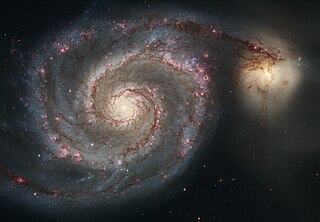
The M51 Group is a group of galaxies located in Canes Venatici. The group is named after the brightest galaxy in the group, the Whirlpool Galaxy (M51A). Other notable members include the companion galaxy to the Whirlpool Galaxy (M51B) and the Sunflower Galaxy (M63).

NGC 4605 is a dwarf barred spiral galaxy in the constellation Ursa Major, located at a distance of 18.1 ± 0.3 megalight-years from the Milky Way. Physically it is similar in size and in B-band absolute magnitude to the Large Magellanic Cloud. It is a member of the M81 Galaxy Group, along with Messier 81 and Messier 101.
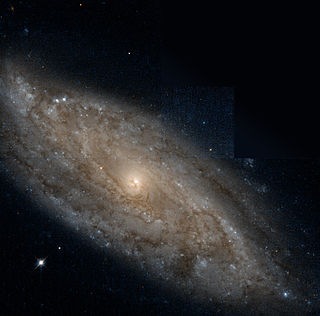
NGC 7314 is a spiral galaxy located in the southern constellation of Piscis Austrinus. It was discovered by English astronomer John Herschel on July 29, 1834. This is a nearby Seyfert (active) galaxy, located at a distance of approximately 54.6 megalight-years from the Milky Way. Since it appears to have detached spiral arm segments, it was listed in Halton Arp's Atlas of Peculiar Galaxies.

NGC 5615 is an irregular galaxy in the constellation Boötes. It is part of the Arp 178 triplet of interacting galaxies with NGC 5614 and NGC 5613. NGC 5615 forms a knot on the outer ring of NGC 5614, with a plume leading away from the knot.
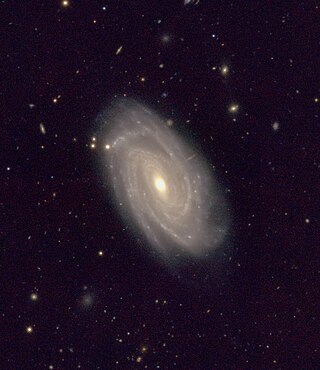
NGC 10 is a spiral galaxy located in the southern constellation of Sculptor. It was discovered by John Herschel on 25 September 1834. The galaxy is located at a distance of 346 Mly from the Sun. Its morphological classification in the De Vaucouleurs system is SAB(rs)bc, where the 'SAB' denotes a weak-barred spiral, '(rs)' indicates a slight ring-like structure, and 'bc' means the spiral arms are moderately to loosely wound. Paturel et al. (2003) assigned this galaxy a classification of SBbc, indicating a barred spiral galaxy.

NGC 3260 is an elliptical galaxy in the constellation Antlia. It is a member of the Antlia Cluster, which lies about 40.7 megaparsecs away. It was discovered on May 2, 1834 by the astronomer John Herschel.

NGC 119 is an unbarred lenticular galaxy with an apparent magnitude of 13.0 located in the constellation Phoenix. It was discovered on October 28, 1834, by the astronomer John Herschel.

NGC 333 is a lenticular galaxy located approximately 755 million light years away in the constellation Cetus. It was discovered in 1877 by Wilhelm Tempel. It is recorded as NGC 333 in the New General Catalogue. It has a companion galaxy, named PGC 3073571, which is presumed to be a physical pair with NGC 333.
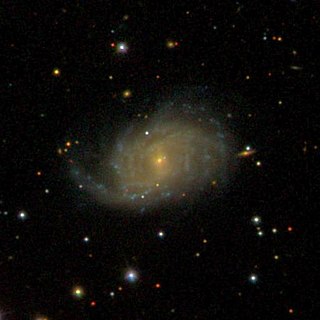
NGC 7046 is a barred spiral galaxy located 193 million light-years away in the constellation of Equuleus. With a high radial velocity of 4,130 km/s, the galaxy is drifting away from the Milky Way. NGC 7046 has an apparent size of 0.990 arcmin, and at its current distance, it has an estimate diameter of 192,639 light years. NGC 7046 has a morphological type of "SBc", which indicates that it is a barred spiral galaxy with a definite bulge.
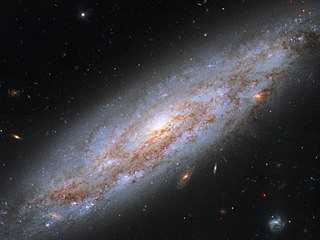
NGC 3972 is a spiral galaxy located in the northern constellation of Ursa Major. It was discovered by William Herschel on April 14, 1789. This galaxy is located 66 million light years away and is receding with a heliocentric radial velocity of 846 km/s. It is a member of the NGC 3992 Group of galaxies.
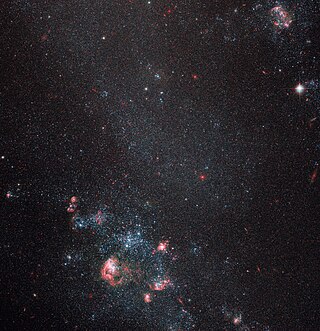
IC 2574, also known as Coddington's Nebula, is a dwarf spiral galaxy discovered by American astronomer Edwin Foster Coddington in 1898. Located in Ursa Major, a constellation in the northern sky, it is an outlying member of the M81 Group. It is believed that 90% of its mass is in the form of dark matter. IC 2574 does not show evidence of interaction with other galaxies. It is currently forming stars; a UV analysis showed clumps of star formation 85 to 500 light-years in size.

NGC 679 is an elliptical or a lenticular galaxy located 210 million light-years away in the constellation Andromeda. The galaxy was discovered by astronomer William Herschel on September 13, 1784 and is a member of Abell 262.

NGC 688 is a barred spiral galaxy with starburst activity located 190 million light-years away in the constellation Triangulum. It was discovered by astronomer Heinrich d'Arrest on September 16, 1865 and is a member of the galaxy cluster Abell 262.

NGC 6902 is an unbarred spiral galaxy located in the southern constellation of Sagittarius at an approximate distance of 124 million light-years (38.0 Mpc). NGC 6902 was discovered on September 2, 1836 by English astronomer John Herschel. In his New General Catalogue, Danish astronomer J. L. E. Dreyer described it as faint, considerably small, round, brighter middle. It is a member of the small NGC 6092 group of galaxies; the LGG 434 group
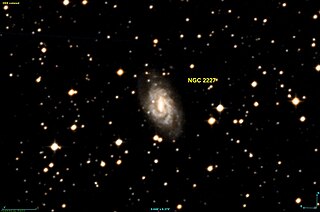
NGC 2227 is a barred spiral galaxy with a morphological type of SB(rs)c located in the direction of the Canis Major constellation. It was discovered on January 27, 1835, by John Herschel.
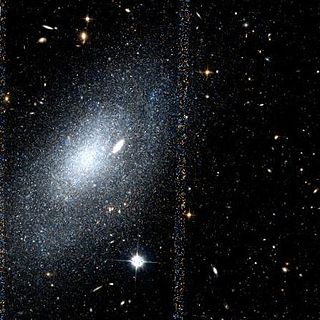
UGC 9405 is a faint dwarf irregular galaxy situated in the constellation of Ursa Major. It is about 20.5 million light-years, or 6.3 megaparsecs, away from the Earth. It is listed as a member of the M101 Group, a group containing the several galaxies orbiting the largest, Pinwheel Galaxy (M101). However, due to its far distance from the Pinwheel Galaxy, its membership of the group is uncertain.

NGC 4343 is an unbarred spiral galaxy in the constellation Virgo. It was discovered by the astronomer William Herschel on April 13, 1784. At a distance of 80 million light-years, it is located in the Virgo Cluster. It contains an active galactic nucleus.




















